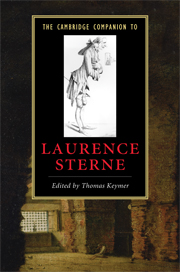Book contents
- Frontmatter
- Introduction
- 1 Laurence Sterne’s life, milieu, and literary career
- 2 Scriblerian satire, A Political Romance, the ‘Rabelaisian Fragment’, and the origins of Tristram Shandy
- 3 Tristram Shandy, learned wit, and Enlightenment knowledge
- 4 Tristram Shandy and eighteenth-century narrative
- 5 The Sermons of Mr. Yorick: the commonplace and the rhetoric of the heart
- 6 A Sentimental Journey and the failure of feeling
- 7 Sterne’s ‘politicks’, Ireland, and evil speaking
- 8 Words, sex, and gender in Sterne’s novels
- 9 Sterne and print culture
- 10 Sterne and visual culture
- 11 Sterne and the Modernist Moment
- 12 Postcolonial Sterne
- Further reading
- Index
- Series List
8 - Words, sex, and gender in Sterne’s novels
Published online by Cambridge University Press: 28 January 2010
- Frontmatter
- Introduction
- 1 Laurence Sterne’s life, milieu, and literary career
- 2 Scriblerian satire, A Political Romance, the ‘Rabelaisian Fragment’, and the origins of Tristram Shandy
- 3 Tristram Shandy, learned wit, and Enlightenment knowledge
- 4 Tristram Shandy and eighteenth-century narrative
- 5 The Sermons of Mr. Yorick: the commonplace and the rhetoric of the heart
- 6 A Sentimental Journey and the failure of feeling
- 7 Sterne’s ‘politicks’, Ireland, and evil speaking
- 8 Words, sex, and gender in Sterne’s novels
- 9 Sterne and print culture
- 10 Sterne and visual culture
- 11 Sterne and the Modernist Moment
- 12 Postcolonial Sterne
- Further reading
- Index
- Series List
Summary
Like many novels, Tristram Shandy is about three things: 'Birth, and copulation, and death', as T. S. Eliot sums up the matter in 'Sweeney Agonistes'. It begins with a bedroom scene (however oblique), focuses on Tristram's difficult birth, and is haunted by death, from Parson Yorick's in the first volume, through Tristram's flight from 'Death himself' in the seventh (TS 7.1.576), to the death of Corporal Trim's brother in the last. (Many other characters die, from Tristram's older brother Bobby to Uncle Toby's friend Le Fever; death scenes recur throughout the text.) But, more than most novels, Tristram Shandy is concerned, some might say obsessed, with 'matter copulative' (8.8.665). Almost any paragraph can make us think of sex, genitalia, male and female organs. We quickly become aware that noses, whiskers, buttonholes, hobby-horses, crevices in the wall, slits in petticoats, old cock'd hats, green petticoats, and even 'things' have more than one meaning - and that Sterne wants us to be aware of them all. Tristram Shandy begins with a joke that structures the whole novel. In the opening chapter, Tristram complains about his parents' inattention as they were busy conceiving him: 'I wish either my father or my mother, or indeed both of them, as they were in duty both equally bound to it, had minded what they were about when they begot me' (TS 1.1.1). Tristram's mother, who has come to associate the two duties that Walter Shandy performs in his regular way on the first Sunday of every month, suddenly asks her husband if he has remembered to wind up the clock.
- Type
- Chapter
- Information
- The Cambridge Companion to Laurence Sterne , pp. 111 - 124Publisher: Cambridge University PressPrint publication year: 2009
- 2
- Cited by



